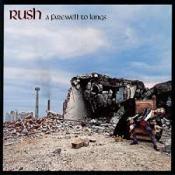20 Rush Albums in 20 Days: A Farewell to Kings
 DAY SEVENTEEN: A Farewell to Kings, running time 37:13, released September 1, 1977
DAY SEVENTEEN: A Farewell to Kings, running time 37:13, released September 1, 1977
2112 was a very good album with great musicianship, but the compositions were harmonically and rhythmically basic. Not so on Rush's followup, A Farewell to Kings. Here, the band pushes the envelope, shifting moods with the effective use of tuned percussion and synthesizers, juggling time signatures and producing one of its finest albums to date.
A Farewell to Kings is all about creating atmosphere, and it often takes its time getting there. Lifeson’s classical guitar that opens the album brings to mind Old England, and the guitar swells that open “Xanadu” evoke mystery and wonder (and lead to my second-favorite Lifeson guitar part of all-time at 1:48). It takes a full five minutes before Geddy sings a note, and it’s this deliberate pace that works so well on the album. Despite the album’s brief length, Rush is in no hurry to get anywhere, each track transpiring all in good time. The marriage of tuned percussion and synthesizer at various points (5:59 of “Xanadu,” for instance) work well, and the musicianship is stunningly good throughout.
Side two opens with a radio-friendly tune (I can only imagine the relief Mercury Records must have felt upon hearing it), “Closer to the Heart,” with its universal lyrics and terrific solo by Lifeson, and “Cinderella Man” is another gem (the cheesy use of panning during the guitar solo notwithstanding) penned by Lee. Both of these tunes are better than any of the shorter tracks on 2112 with the possible exception of ”A Passage to Bangkok.” The band had grown in leaps and bounds in one year. Even the ballad “Madrigal” works beautifully and benefits from brevity, something Rush should have considered with “Rivendell” just a few years prior, and it also works better than the ballad “Tears” from 2112.
The album ends with another ambitious effort, “Cygnus X-1,” and once again the pacing is superb. After a brief spoken introduction, it isn’t until minute five that Geddy begins to sing. The song rocks at that point, only to recede at 7:15, building the tension required to highlight the song’s inevitable, blistering conclusion. The strummed guitar chords at the song's end leave the listener with a sense of mystery and suggest the song's sequel, ”Hemispheres."
In short, A Farewell to Kings may not be the album you want to listen to in the car between errands after work, but if you’ve got some time to sit back and take it all in, you might not find a better Rush album. It’s likely going to be number two on my list.
Tomorrow, I’ll be listening to…drum roll, please…number 19, Snakes and Arrows, one of those efforts that newer Rush fans worship. We’ll see what this old guy thinks of it.